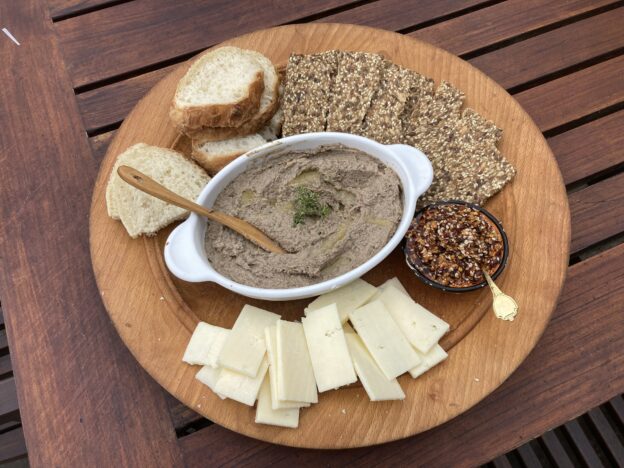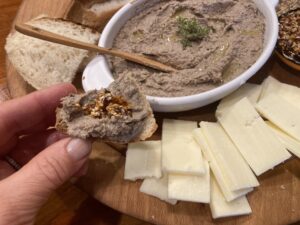November in the east is full-on stick season, a term which, thanks to local boy turned massive celeb Noah Kahan, needs no further explanation. You could listen to the song or just look outside my window at the inspiring brown on brown on brown tableau. Despite the catchy song, it’s not hugely inspiring weather. BUT it is good for hunkering in with hearty fare, which is reason enough to add this fully Vegan and exceptionally delish “pâté” to your stick season repertoire.
This recipe has been on my “to-post” list for months because it multi tasks like a boss and is a hit with Vegans and carnivores alike. It’s worth reading the whole origin story here to see how this umami party came together. I have never been a fan of pâté, so an exact replication of it was never a huge priority. That said, I’m glad Alanna went the distance because this happens to be spot on in texture and, as far as I am concerned, as good or better in taste.
The one weird ingredient is umeboshi—pickled plum paste—which is not a deal killer to substitute (see notes), but worth tracking down. You don’t need much and it keeps as long as anything in my science project fridge. Stick season is also hunting season, which gets to feeling pretty meaty in these parts. Having a tub of this on hand is a brilliant way to fight back and get your veggies in at any meal.
This is especially good with Everyone Crackers, (another gift from the Bojon Gourmet), but great as a sandwich spread or on any app platter with things like cornichons, baguette slices, sturdy veggies, etc. Fergawdssakes don’t forget the chile crisp!
I hope you like this and you’re enjoying the hunkering wherever you are!
Lentil Walnut Vegan Pâté
From the Bojon Gourmet, Alanna Taylor-Tobin
Prep Time: 15 minutes
Cook Time: 35 minutes
Total: 50 minutes
Servings: 8 to 10 appetizer servings (makes about 3 cups—a LOT)
Ingredients
- 3/4 cup dried green lentils** (lentils de puy)
- 3 cups water
- 1 bay leaf
- 3 tablespoons olive oil (divided use)
- 1 small, yellow onion, chopped
- 6 cloves garlic, peeled and coarsely chopped
- 1 tablespoon mirin
- 1 1/4 cups walnuts, lightly toasted (for 6 – 12 minutes at 350º) and cooled
- 1/3 cup fresh cilantro, basil or parsley, plus extra for garnish, chopped
- 1 tablespoon chopped fresh thyme, oregano or marjoram, chopped
- 3 tablespoons white or yellow miso paste
- 1 1/2 tablespoons umeboshi paste*
- 3/4 teaspoon freshly ground black pepper
- extra olive oil, for drizzling
Method
- In a medium saucepan, combine the lentils, water and bay leaf. Bring to a boil, then reduce to a simmer and cook, partially covered and stirring occasionally, until the lentils are very tender (but not falling apart), 20 – 30 minutes. Drain, discard the bay leaf, and cool completely (you can speed this up by spreading the lentils out on a plate and sticking them in the fridge).
- Meanwhile, heat 2 tablespoons of the olive oil in a heavy skillet over medium heat. Add the onion and garlic and saute, stirring frequently and reducing the heat if necessary, until the onions are golden, about 15 minutes. Stir in the mirin and remove from the heat. Cool completely (to speed up the process, see lentils, above).
- Place the toasted and cooled walnuts in the bowl of a food processor and puree until it looks like nut butter, scraping the sides of the bowl as needed. Add the cooled lentils and the onion mixture and puree smooth. Add in the herbs, miso, umeboshi, pepper, and remaining tablespoon of olive oil, and blend until smooth.
- Serve immediately, or store in the refrigerator for up to a week. Drizzle with olive oil and chopped fresh herbs, and serve with crackers or sliced baguette and cornichons or olives.
Notes:
The unique flavor profile comes from a trifecta of Japanese ingredients—miso, mirin and umeboshi—all of which I can find EVEN in NH. Of the three, Umeboshi is least likely to be in your kitchen. It is described as sour, salty and slightly sweet.
*Teresa, my way-better-chef-than-me friend and neighbor used a sour plum jam mixed with some balsamic vinegar with great success.
** I have used regular brown lentils when I ran out of de puys and they were totally fine.




